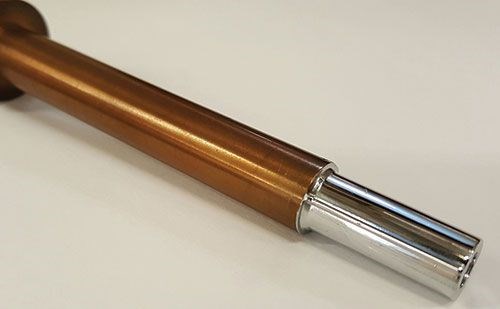Plating Improves Beryllium Copper Molds
Moldmakers often overlook surface treatment as a way to further maximize the life and performance of beryllium copper molds.
Beryllium copper has long been used for complex moldmaking applications because of its good thermal conductivity, which ensures better control over cooling rates, leading to decreased cycle times, increased productivity and reduced manufacturing costs. However, moldmakers often overlook surface treatment as a way to further maximize mold life and performance.
It’s important to know up front that plating does not affect the integrity of the beryllium copper, because it does not have an insulating effect. Whether coating with chrome, electroless nickel, electroless nickel co-deposited with polytetrafluoroethylene (PTFE), or boron nitride, the base material’s thermal conductivity properties remain intact. What is gained is increased protection due to added hardness.
Another benefit of plating is that the coating serves as a wear indicator. When the color of the beryllium copper starts to show through, it’s a signal that maintenance will soon be required. Usually, wear first occurs around or opposite the gate.
Finally, plating beryllium copper increases lubricity, since most coatings have a lower coefficient of friction than the base material. This helps alleviate any release issues, while reducing cycle times and increasing productivity.
Specific design features can make a mold an ideal candidate for plating. For example, when part distortion is a concern, beryllium copper is often used for the main core, since the higher thermal conductivity will aid mold release. In those cases, adding a coating will further ease release.
If mold protection is a main objective, the material being processed becomes an important consideration when using beryllium copper. For example, during plastic injection molding applications, beryllium copper needs protection from the abrasive plastic parts. Similarly, plating will protect beryllium copper molds when molding glass-filled, mineral-filled and nylon materials. In such cases, chrome plating can serve as a coat of armor for the beryllium copper. However, if lubricity or preventing corrosion have been identified as priorities, then a nickel product would be a better choice.
Finish is a final consideration for plating. Any desired finish can be plated and accommodated, however, keep in mind that different combinations of finishes and coating types can achieve different goals. Light and low-pressure bead blasting helps to ease release by microscopically breaking up the surface of the mold, which reduces surface area and creates fewer opportunities for sticking. Clean release will also improve part quality, reducing the likelihood of part distortion and other issues.
To enhance mold performance with a surface treatment, start discussing options with the plater before the tool is built. At that point, various factors can be identified, helping the plater determine the best solution for the job. Then the moldmaker has the opportunity to make some tweaks based on plater recommendations.
Related Content
-
Predictive Manufacturing Moves Mold Builder into Advanced Medical Component Manufacturing
From a hot rod hobby, medical molds and shop performance to technology extremes, key relationships and a growth strategy, it’s obvious details matter at Eden Tool.
-
What is Scientific Maintenance? Part 2
Part two of this three-part series explains specific data that toolrooms must collect, analyze and use to truly advance to a scientific maintenance culture where you can measure real data and drive decisions.
-
Portable Low-Heat, Non-Arcing Resistance Welder for Mold Repair
Rocklin’s user-friendly MoldMender Micro Welder delivers simple and cost-effective localized repair in-house with precision and versatility, enhancing mold and die durability and reducing disassembly and downtime.

















